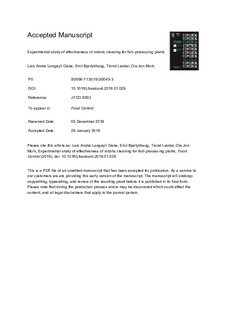| dc.contributor.author | Giske, Lars André Langøyli | |
| dc.contributor.author | Bjørlykhaug, Emil Dale | |
| dc.contributor.author | Løvdal, Trond | |
| dc.contributor.author | Mork, Ola Jon | |
| dc.date.accessioned | 2019-02-26T13:53:27Z | |
| dc.date.available | 2019-02-26T13:53:27Z | |
| dc.date.created | 2019-02-21T16:10:08Z | |
| dc.date.issued | 2019 | |
| dc.identifier.citation | Food Control. 2019, 100 269-277. | nb_NO |
| dc.identifier.issn | 0956-7135 | |
| dc.identifier.uri | http://hdl.handle.net/11250/2587562 | |
| dc.description.abstract | This paper presents the development and experimental testing of the effectiveness of a robotic cleaning system for fish processing plants. The processing of fish introduces a substantial risk of bacterial contamination, which can cause the spoilage of fish and pose a threat to consumers’ health. Good operational hygiene and precautions, in addition to regular cleaning of the processing plants, are necessary for the reduction of the risk of contamination. The state-of-the art cleaning techniques currently include manual cleaning operations of fish processing plants. The experiments of robotic cleaning presented in this paper were performed in two rounds. First, a test using a conventional low-cost industrial robot mounted on a vertical linear axis was used. As the results from this test seemed promising, a second robotic system was built aiming at a more industrialized version. This system consisted of a serial manipulator, tailored for the task, mounted on a horizontal transportation system, and a comparison was conducted between the cleaning performed by human operators and that performed by the robotic system. An electrical stunner with a connected conveyor belt, which is a typical installation for salmon processing plants, was experimentally inoculated with a cocktail of fish-spoilage bacteria that were allowed to develop a biofilm. Back-to-back cleaning trials with biofilms of Pseudomonas fluorescens, Pseudomonas putida, and Photobacterium phosphoreum confirmed that the industrialized robotic prototype performed equally well or better than the conventional manual cleaning procedure currently used in the industry. The results demonstrate that a robotic system can deliver satisfactory results in the cleaning of fish processing plants, thereby minimizing the potential for the spread of contamination. The proposed robotic concept allows for an automated cleaning system, reduced human labor, increased profitability for the industry, and better stability of the cleaning process. | nb_NO |
| dc.language.iso | eng | nb_NO |
| dc.publisher | Elsevier | nb_NO |
| dc.rights | Attribution-NonCommercial-NoDerivatives 4.0 Internasjonal | * |
| dc.rights.uri | http://creativecommons.org/licenses/by-nc-nd/4.0/deed.no | * |
| dc.title | Experimental study of effectiveness of robotic cleaning for fish-processing plants | nb_NO |
| dc.type | Journal article | nb_NO |
| dc.type | Peer reviewed | nb_NO |
| dc.description.version | acceptedVersion | nb_NO |
| dc.source.pagenumber | 269-277 | nb_NO |
| dc.source.volume | 100 | nb_NO |
| dc.source.journal | Food Control | nb_NO |
| dc.identifier.doi | 10.1016/j.foodcont.2019.01.029 | |
| dc.identifier.cristin | 1679694 | |
| dc.description.localcode | © 2019. This is the authors’ accepted and refereed manuscript to the article. Locked until 30 January 2020 due to copyright restrictions. This manuscript version is made available under the CC-BY-NC-ND 4.0 license http://creativecommons.org/licenses/by-nc-nd/4.0/ | nb_NO |
| cristin.unitcode | 194,64,92,0 | |
| cristin.unitcode | 194,64,93,0 | |
| cristin.unitname | Institutt for maskinteknikk og produksjon | |
| cristin.unitname | Institutt for havromsoperasjoner og byggteknikk | |
| cristin.ispublished | true | |
| cristin.fulltext | postprint | |
| cristin.qualitycode | 1 | |

